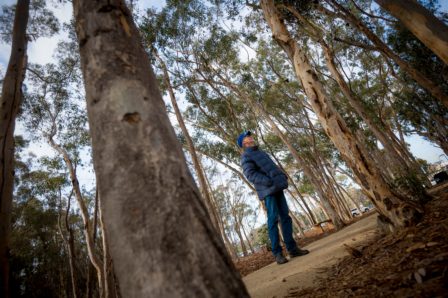Composer John Luther Adams’ ‘The Wind Garden’ Debuts
19th Addition to the Stuart Collection at the UCSD

Pulitzer Prize-winning composer John Luther Adams stands among the trees that inspire his musical endeavors.
It’s early morning and you’re strolling through a grove of eucalyptus trees when you hear the sounds, like bells softly trilling. Or is the wind whispering through the tall branches above? It is not your imagination; you have discovered the “The Wind Garden,” the 19th public art work of the renowned Stuart Collection at the University of California San Diego. In this installation by Pulitzer Prize-winning composer John Luther Adams, the leafed choir sings in response to the subtle shifts in light, wind and seasons.
The campus and local community are invited to explore the new installation at a public reception with the artist from 1 to 3 p.m., Monday, August 7. “The Wind Garden” is currently serenading visitors at all hours of the day and night—often to the surprise of unsuspecting passers-by. The installation is meant to be essentially invisible. A team of composers, electronics engineers, arborists and data designers collaborated to bring the piece to life, utilizing a sustainable framework that leaves the grove virtually untouched.
So how exactly can trees sing? Adams was invited to work with the signature landscape of UC San Diego, and chose a grove west of the Mandel Weiss Theater. Thirty-two eucalyptus trees have been fitted with motion and light sensors that translate varying forces of wind and changing light patterns into sound instantaneously by sophisticated software. Speakers high in the canopy above project the sound, louder during strong gusts and sunny, summer weather; while subwoofers at ground level emanate more subtle, deep tones as darkness descends and winter prevails.
Each journey through the soundscape is a unique experience. The trees are not performing a finite composition, they are actively narrating the forces of nature happening in real time. Wherever you are in the grove, you are embraced by a polyphony of sounds, with no one ideal spot for listening. For those desiring a concentrated experience, they can linger in a small circular copse where the trees and speakers are more closely nestled. Others may choose to repose on one of the benches scattered through the space, made of reclaimed eucalyptus tree wood.
Instead of trying to evoke a certain experience or meaning, Adams’ work strives to cultivate subjective awareness and presence between ourselves and our environment. He explains, “The truth is, I am not interested in making music about anything. A piece may begin with a particular thought or image, but as the music emerges, it becomes a world of its own, independent of any extra-musical associations that I may have. The last thing that I want to do is tell you what to hear, to limit your experience, your imagination.”
It was in 2007 when Mary Beebe, director of the Stuart Collection, first heard Adams’ music performed live by the La Jolla Symphony and Chorus—directed by UC San Diego Professor of Music Steven Schick. Adams’ piece, “The Light That Fills the World,” brought the forces of nature into the concert hall. Beebe was drawn to the artist’s desire to create place with his music, something that the Stuart Collection’s site-specific works also strive to accomplish.
Adams, whose career as a composer has spanned four decades, has been creating sonic installations for the past 12 years. Many of his compositions were performed indoors. When he ventured to move his 99-drummer percussion piece, “Inuksuit,” outside to the unforgiving badlands of the Anza Borrego Desert, he was stunned to find the powerful pitch simply float away when unconstrained. It was then that he had an epiphany: why not create music that is intended to be heard outdoors from the start?
“Making music outdoors invites a different mode of awareness; you might call this ecological listening,” said Adams. “When we are in a concert hall, we close the doors and we try to seal ourselves off from the outside world. Outdoors, rather than focusing our attention inward, we are invited to receive messages not just from a composer or musicians, but from a larger world in which the music is sounding.”
His works today, especially “The Wind Garden,” are imbued with this reverence for the earth. “Music is not what I do, it’s how I understand the world—and for me, the whole world is music,” said Adams. “As a composer, it’s my belief that music can contribute to the awakening of our ecological understanding. By deepening our connections to the earth, music can provide a sounding model for the renewal of human consciousness and culture.”
“The Wind Garden” is one of 19 site-determined installations that comprise the Stuart Collection, and each have a unique story to tell. The works, which have been sprouting across the 1,200-acre campus for the past three decades, represent an impressive assemblage of public art from visionaries such as Robert Irwin, Niki de Saint Phalle, Bruce Nauman and Kiki Smith. Visitors are invited to take a free, self-guided tour, perfect for families and art aficionados alike.
“What I like about the Stuart Collection is that you don’t run into it with a museum frame of mind, you just happen upon the works,” said Beebe. “Each is a completely different kind of experience, like a treasure hunt.”
All commissions are completely funded by private donations, including support from the Friends of the Stuart Collection, a growing network of arts enthusiasts. To learn more about the Stuart Collection, visit their website www.ucsd.edu.
Category: Local News, Music







